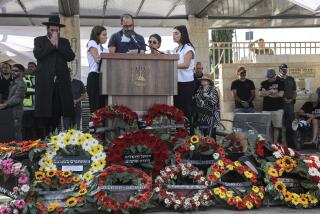Thousands in Israel Protest Possible Loss of the Golan
- Share via
TEL AVIV — As Israeli-Syrian peace talks wound down near Washington, tens of thousands of Israelis poured into this city’s main square Monday to demonstrate their fervent opposition to relinquishing the Golan Heights in any peace deal.
Police said the protest drew more than 100,000 people, well below organizers’ predictions but enough to send a powerful message to Prime Minister Ehud Barak about the strong--and evidently growing--resistance to withdrawal.
“We are not leaving the Golan,” declared Eli Malka, a leader of the 17,000 Jews who have settled there since Israel captured it from Syria in the 1967 Six-Day War. Then he addressed Barak: “If you think we will just sit in our houses and let you tear apart the country, you are wrong. We are the majority, and we will win.”
Barak has promised to hold a binding national referendum on any agreement he reaches with Syria. But recent polls indicate that winning the vote could be difficult. A small but growing majority of Israelis say they favor keeping the Golan, even at the expense of peace with Syria.
Syrian President Hafez Assad says he will not sign a treaty that does not include the return of the Golan, a fertile swath of land that stretches northeast from the Sea of Galilee. Barak has said Israel must be prepared to make “painful concessions” for peace, a statement Israelis take as an indication that he ultimately will agree to hand over all or most of the strategic plateau in exchange for security guarantees and normal diplomatic relations with the Arab state.
Many Israelis say they fear that Barak already has agreed to a withdrawal, pointing to the publication Sunday in the London-based Arabic newspaper Al Hayat of what the paper said was the American “working document” that served as the basis of the last few days of talks. Al Hayat’s report said Israel had agreed to pull back to the 1923 international border--in other words, to withdraw from the entire Golan.
Although Israel and the State Department denied the account, many remain suspicious that a deal already has been cut.
“There is no drawing of borders and there are no agreements,” Foreign Minister David Levy told reporters upon his return to Israel.
Opposition leader Ariel Sharon called on Barak to address the Israeli parliament immediately upon his return from the United States later today. And, judging by the size of Monday’s crowd, many other Israelis are worried as well.
Organizers of Monday’s protest had hoped to equal or surpass the biggest rally in Israeli history, a gathering of 300,000 to 400,000 in 1982 to protest the war in Lebanon.
“Why, in a peace agreement, should people be forced from their homes and have their communities destroyed?” asked Marla Van Meter, an immigrant from California who has lived in the Golan for 17 years and helped organize Monday’s rally. “How can anyone call that a real peace?”
Van Meter, who grew up in Santa Maria and now lives on a collective farm in the Golan, said the litmus test for true peace “should be people living side by side with each other, not the destruction of homes and livelihoods.”
Near the stage, a huge, illuminated map of the territory loomed over the crowd, which nearly filled the giant square near Tel Aviv’s City Hall. The plaza, Israel’s traditional protest site and often the scene of large peace rallies, is named after Yitzhak Rabin, the prime minister who was killed here in 1995 by a Jewish extremist determined to stop the peace process with the Palestinians.
Protesters, for the most part youthful and dressed in the skullcaps and modest clothing of religious Jews, waved placards and blue-and-white Israeli flags as speakers, including Golan residents, rabbis, and well-known peace activists, addressed the crowd. Loudspeakers played recordings of Rabin stressing the importance of the Golan to Israel’s security, and teenagers passed out bumper stickers reading: “Peace WITH the Golan.”
More to Read
Sign up for Essential California
The most important California stories and recommendations in your inbox every morning.
You may occasionally receive promotional content from the Los Angeles Times.













